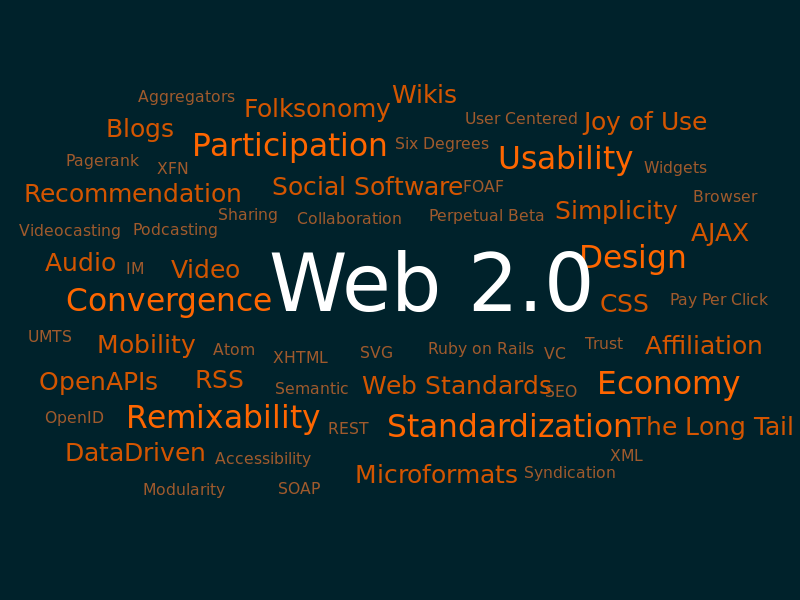Web 1.0, 2.0 and 3.0
"
 Web 1.0, or web refers to the first stage of the World Wide Web linking webpages with hyperlinks (Hyper Text Transfer Protocol or http). To take an example from above, Personal web pages were common in Web 1.0, and these consisted of mainly static pages hosted on free hosting services. Nowadays, dynamically generated blog and social networking profiles, such as Myspace and Facebook, are more popular, allowing for readers to comment on posts in a way that was not available during Web 1.0. Personal or institutional sites were static, web pages were designed with frames and they were impersonal. There was no interaction, the administrator was the only one who could modify or change the site. Users were only readers¨ according to Wikipedia.
Web 1.0, or web refers to the first stage of the World Wide Web linking webpages with hyperlinks (Hyper Text Transfer Protocol or http). To take an example from above, Personal web pages were common in Web 1.0, and these consisted of mainly static pages hosted on free hosting services. Nowadays, dynamically generated blog and social networking profiles, such as Myspace and Facebook, are more popular, allowing for readers to comment on posts in a way that was not available during Web 1.0. Personal or institutional sites were static, web pages were designed with frames and they were impersonal. There was no interaction, the administrator was the only one who could modify or change the site. Users were only readers¨ according to Wikipedia. The term Web 2.0 is associated with web applications that facilitate participatory information sharing, user-centered design and collaboration on the World Wide Web. A Web 2.0 site allows users to interact and collaborate with each other in a social media dialogue as creators of user-generated content in a virtual community, in contrast to websites where users/consumers are limited to the passive viewing of content that was created for them. Examples of Web 2.0 include social networking sites, blogs, wikis, video sharing sites, hosted services among others.
Web 2.0 websites allow users to do more than just retrieve information. Web 2.0 provides the user with more user-interface, software and storage facilities, all through their browser. Users can provide the data that is on a Web 2.0 site and exercise some control over that data. These sites may have an "Architecture of participation" that encourages users to add value to the application as they use it.
¨The Web 2.0 offers all users the same freedom to contribute. While this opens the possibility for rational debate and collaboration, it also opens the possibility for "spamming" and "trolling" by less rational users. This requires what is sometimes called radical trust by the management of the website. According to Best, the characteristics of Web 2.0 are: rich user experience, user participation, dynamic content, metadata, web standards and scalability. Further characteristics, such as openness, freedom and collective intelligence by way of user participation, can also be viewed as essential attributes of Web 2.0¨ as Best states.
Web 3.0
Web 3.0
Definitions of Web 3.0 vary greatly. Some believe its most important features are the Semantic Web and personalization. Focusing on the computer elements, Conrad Wolfram has argued that Web 3.0 is where "the computer is generating new information", rather than humans.
Andrew Keen, author of The Cult of the Amateur, considers the Semantic Web an "unrealisable abstraction" and sees Web 3.0 as the return of experts and authorities to the Web. Some authors propose that Web 3.0 will be a "Totally Integrated World" - cradle-to-grave experience of being always plugged onto the net¨ as stated in Wikipedia/SemanticWeb.
What is undoubtedly is that students worldwide can benefit from the three Webs 1.0, 2.0 and 3.0 in the sense that they can access recent information most of the times at the very moment it is generated which gives an added value to the Webs. Depending on what a learner or user needs to find out such learner can look up for static information on the Web 1.0, criticize it, share it and improve it within learning communities worldwide using the Web 2.0 and by means of the use of Web 3.0 become experts by the fact of empowering and enhancing it through collaborative and constructivist exchange with others.
The world is now at our feet and with a simple click it can be opened immediately. This is something that we as teachers have to manage very well with our learners because there is a huge responsibility in the sense that not all the information is reliable and useful, therefore, teachers have to play important roles as monitors, guides and councelors. It is important to teach our students on how to use the Web.
References:
http://en.wikipedia.org/wiki/Web_2.0
http://en.wikipedia.org/wiki/Semantic_Web
References:
http://en.wikipedia.org/wiki/Web_2.0
http://en.wikipedia.org/wiki/Semantic_Web



No comments:
Post a Comment